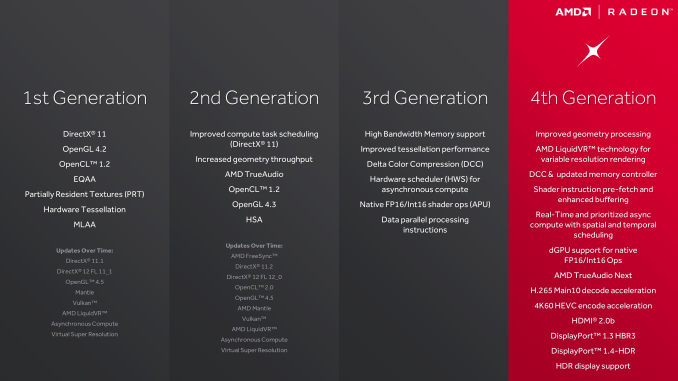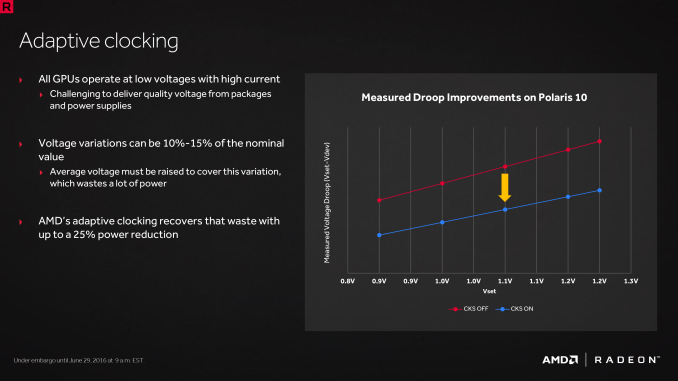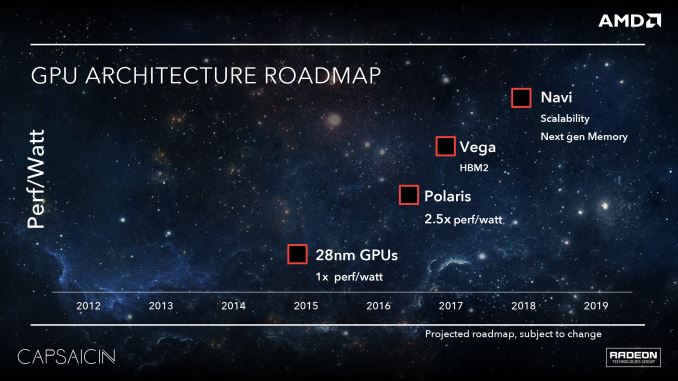The AMD Radeon RX 480 Preview: Polaris Makes Its Mainstream Mark
by Ryan Smith on June 29, 2016 9:00 AM ESTAMD's Path to Polaris
With the benefit of hindsight, I think in reflection that the 28nm generation started out better for AMD than it ended. The first Graphics Core Next card, Radeon HD 7970, had the advantage of launching more than a quarter before NVIDIA’s competing Kepler cards. And while AMD trailed in power efficiency from the start, at least for a time there they could compete for the top spot in the market with products such as the Radeon HD 7970 GHz Edition, before NVIDIA rolled out their largest Kepler GPUs.
However I think where things really went off of the rails for AMD was mid-cycle, in 2014, when NVIDIA unveiled the Maxwell architecture. Kepler was good, but Maxwell was great; NVIDIA further improved their architectural and energy efficiency (at times immensely so), and this put AMD on the back foot for the rest of the generation. AMD had performant parts from the bottom R7 360 right up to the top Fury X, but they were never in a position to catch Maxwell’s efficiency, a quality that proved to resonate with both reviewers and gamers.
The lessons of the 28nm generation were not lost on AMD. Graphics Core Next was a solid architecture and opened the door to AMD in a number of ways, but the Radeon brand does not exist in a vacuum, and it needs to compete with the more successful NVIDIA. At the same time AMD is nothing if not scrappy, and they can surprise us when we least expect it. But sometimes the only way to learn is the hard way, and for AMD I think the latter half of the 28nm generation was for the Radeon Technologies Group learning the hard way.
So what lessons did AMD learn for Polaris? First and foremost, power efficiency matters. It matters quite a lot in fact. Every vendor – be it AMD, Intel, or NVIDIA – will play up their strongest attributes. But power efficiency caught on with consumers, more so than any other “feature” in the 28nm generation. Though its importance in the desktop market is forum argument fodder to this day, power efficiency and overall performance are two sides of the same coin. There are practical limits for how much power can be dissipated in different card form factors, so the greater the efficiency, the greater the performance at a specific form factor. This aspect is even more important in the notebook space, where GPUs are at the mercy of limited cooling and there is a hard ceiling on heat dissipation.
As a result a significant amount of the work that has gone into Polaris has been into improving power efficiency. To be blunt, AMD has to be able to better compete with NVIDIA here, but AMD’s position is more nuanced than simply beating NVIDIA. AMD largely missed the boat on notebooks in the last generation, and they don’t want to repeat their mistakes. At the same time, starting now with an energy efficient architecture means that when they scale up and scale out with bigger and faster chips, they have a solid base to work from, and ultimately, more chances to achieve better performance.
The other lesson AMD learned for Polaris is that market share matters. This is not an end-user problem – AMD’s market share doesn’t change the performance or value of their cards – but we can’t talk about what led to Polaris without addressing it. AMD’s share of the consumer GPU market is about as low as it ever has been; this translates not only into weaker sales, but it undermines AMD’s position as a whole. Consumers are more likely to buy what’s safe, and OEMs aren’t much different, never mind the psychological aspects of the bandwagon effect.
Consequently, with Polaris AMD made the decision to start with the mainstream market and then work up from there, a significant departure from the traditional top-down GPU rollouts. This means developing chips like Polaris 10 and 11 first, targeting mainstream desktops and laptops, and letting the larger enthusiast class GPUs follow. The potential payoff for AMD here is that this is the opposite of what NVIDIA has done, and that means AMD gets to go after the high volume mainstream market first while NVIDIA builds down. Should everything go according to plan, then this gives AMD the opportunity to grow out their market share, and ultimately shore up their business.
As we dive into Polaris, its abilities, and its performance, it’s these two lessons we’ll see crop up time and time again, as these were some of the guiding lessons in Polaris’s design. AMD has taken the lessons of the 28nm generation to heart and have crafted a plan to move forward with the FinFET generation, charting a different, and hopefully more successful path.
Though with this talk of energy efficiency and mainstream GPUs, let’s be clear here: this isn’t AMD’s small die strategy reborn. AMD has already announced their Vega architecture, which will follow up on the work done by Polaris. Though not explicitly stated by AMD, it has been strongly hinted at that these are the higher performance chips that in past generations we’d see AMD launch with first, offering performance features such as HBM2. AMD will have to live with the fact that for the near future they have no shot at the performance crown – and the halo effect that comes with it – but with any luck, it will put AMD in a better position to strike at the high-end market once Vega’s time does come.













449 Comments
View All Comments
xthetenth - Wednesday, June 29, 2016 - link
It's a small chip and cheap card, so the design is delivering on the goal of making that level of performance cheap.fanofanand - Wednesday, June 29, 2016 - link
The problem as I see it, is that it's barely cheaper than a 970 that performs similarly. I get the whole 3.5 Gb issue with the 970, but based on those charts they are neck and neck with the 970 often beating it. Maybe my expectations were out of whack, but I had really hoped that AMD would be offering 970 performance for 960/950 pricing, given the updated node.Drumsticks - Wednesday, June 29, 2016 - link
I'm not expecting an /upgrade/ from the 390, but any insight into why the 480 barely beats the 390 despite 10% more shaders? Where are all of the uarch changes going to? Is it a lack of ROPs? That's about the only thing I can think of. Performance at 1440p seems fairly eh.watzupken - Wednesday, June 29, 2016 - link
I think its ROP starved. Which is typically the case for cards in the mid range.zoxo - Wednesday, June 29, 2016 - link
32 ROPs are very much more at home at 1080p. U have some leeway with frequency, but 1440p is a big jump in pixel count.D. Lister - Wednesday, June 29, 2016 - link
Yes, 32 ROPs vs 64 ROPs of the 390. It really only starts showing at >1080p resolutions though.extide - Wednesday, June 29, 2016 - link
480 has LESS shaders than 390.480 - 2304
390 - 2560
390X - 2816
smackosaurus - Wednesday, June 29, 2016 - link
So no 980 in the chart?Would be interesting to see a comparison in DX12 with the 480 and 980, but somehow after week of people saying the 480 was near 980 levels in DX 12...the 980 was somehow left out.
Great job.
Ryan Smith - Wednesday, June 29, 2016 - link
You can find that data (and more) in Bench: http://www.anandtech.com/bench/product/1748?vs=171...Otherwise 980 isn't in these charts as it's not really a meaningful comparison. Retail sales have already started winding down, and in terms of performance the RX 480 averages just 3% ahead of GTX 970. It's not a 980-level card.
warreo - Wednesday, June 29, 2016 - link
I have to disagree with you Ryan. People (unfairly or not, just read the all the comments) expected this to land somewhere between 970/980, so I really am not sure how you can say it's "not really a meaningful comparison." To me, it's good to know that it's basically equivalent to a 970, but also useful to know that it's on average 15-20% slower than a 980 by extension.Again, I could (and did) look it up on the Bench, but it would have been useful to have in the charts off the bat.